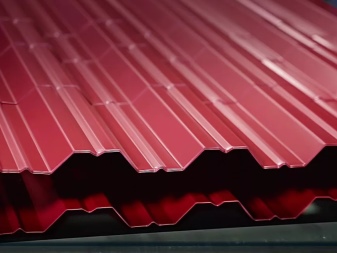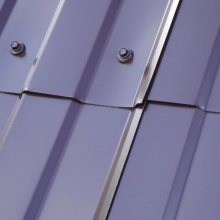Features of C18 corrugated board

Knowing the features of C18 corrugated board is very important for all its buyers. By understanding the basic dimensions and other specifications, many mistakes and problems can be avoided. And also it is worth paying attention to the installation of a profiled sheet in graphite color and other possible colors.


Specifications
The production of a professional sheet of category C18 is carried out in accordance with the technical conditions (TU) 1122. The standard always provides for the use of cold-rolled steel, clearly divided into thin sheets. This material must be necessarily galvanized. Compliance with the material GOST 52146, in force since 2003, is always provided. A common requirement of technologists is also the application of painting on both sides.
In general, type C18 structures at the same time:
- lightweight;
- durable;
- allow you to save a lot of money compared to other options.


The surface of the profiled sheet can be both flat and made with a wave. The dimensions of the platform between the waves are exactly 9.2 cm. The standard step of the trapezoid is 28.8 cm. Since it is quite large, reinforcing stiffeners are imperative.
Other main dimensions:
- the height of the corrugated (wavy) sections - 1.8 cm;
- standard sheet width - 119 or 102.3 cm;
- useful area in width - 115 or 100 cm;
- steel layer thickness - from 0.4 to 0.8 mm;
- typical length - 1-12 m (the sheet can be cut to any arbitrary size within these lengths).

The surface is protected by various polymeric materials. Most often it is polyester and plastisol. But foreign substances Colorcoat Prisma TM, Granite Cloudy can also be used.
It is worth noting that the difference often concerns:
- the thickness of the insulating layer;
- the level of visible gloss;
- permissible operating temperature (minimum 60, usually 80, rarely 120 degrees);
- permissible bending radii of the sheet;
- adhesive retention upon impact from the reverse side;
- resistance to salt fog (with normal acidity of the appearing environment);
- mass of one running meter;
- the masses of one useful "square" on the sheet;
- permissible deviation in length, width and height of a single element.


Quite a few users choose a graphite color profiled sheet. This shade of gray looks very good and turns out to be very practical even in ambiguous cases. The official designation for the graphite color is RAL 0724. You have to understand that it belongs to the dark part of the spectrum. Therefore, it is not always a good idea to use such a solution for continuous cladding of large areas.
In some cases, the HPS or RR color scale can be used. The main nuances are as follows:
- red color stylistically refers to brick and tile;
- brown tones are ideally combined with wooden structures;
- green in the form of any shade looks quite natural and fresh;
- the lighter the color, the visually wider the structure will look (and vice versa).

Applications
As it is already clear, C18 corrugated board is quite solid and promising material for various purposes. It is used to:
- to arrange the roof on a continuous crate;
- to build "fast" structures;
- prepare small architectural forms;
- make sheds (over the threshold, over a car parking space, over firewoods, and so on);
- form frame structures;
- make shield-type barriers;
- protect walls (and decorate them at the same time);
- to build insulated sandwich walls;
- build fences.



Mounting
It is possible to use C18 profiled sheet for roofing only on secondary structures. For capital residential buildings, this is not very practical and convenient. Blocks can be fed to the roof either manually or by pushing along pre-laid boards. Cutting corrugated board with an abrasive tool is not allowed. You can use electric or steel beaver cutting shears.
A high-quality lathing is certainly needed under the profiled sheet. Initially, hooks are placed on which the gutter and the eaves strip will be fixed. Next, a ridge bar is installed. Only after it comes the time for the end plate.
Sheets can be mounted exclusively on solid self-tapping screws with EPDM gaskets.



Recommendations:
- strictly control the tightening (it should not be excessive);
- lay the first sheet with the guiding section towards the end;
- placement of the transverse joint exactly on the crate;
- if possible, weld corrugated board when it comes to fences;
- choose self-tapping screws according to the color and technical characteristics of the sheet material;
- carefully measure and check everything before starting work;
- fix the sheets on the fence with an overlap;
- treat all welding points with protective substances so that they do not deteriorate so much over time;
- drill holes strictly according to the level, also controlling their distance between themselves.
When making a fence made of corrugated board, it is imperative to put the bar on the upper line of the fence. Its color must match the chosen design variation. Such a part is usually fixed with self-tapping screws. The role of the plank is to stylistically complete the composition. Otherwise, there is nothing complicated in this, and the installation of corrugated board is quite accessible even to non-professionals.















The comment was sent successfully.